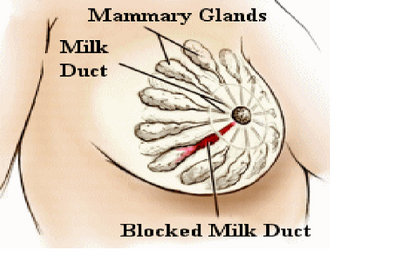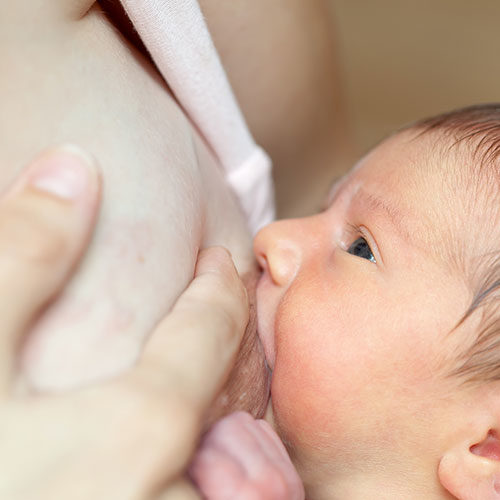What are Plugged/Clogged Ducts?
As the name suggests, a plugged or clogged duct is an obstructed milk duct in the breast.
A breastfeeding woman may notice it as a small hard lump which feels tender, little swollen, sometimes red and slightly hot. When a milk duct is obstructed, it can happen at the pore in the form of a milk blister, or deep inside the ductal system where one can’t really see it, but can only be felt.
When the milk flow is obstructed in a duct, the milk accumulates there as it is unable to flow out. This accumulated milk causes inflammation. If it is ignored, it can lead to mastitis. If it gets further infected, it could escalate into a breast abscess which, in most cases, needs surgery.
Common causes of a plugged duct
1) Usually, a plugged duct occurs when the breast is not drained effectively and efficiently. This can happen due to a variety of reasons.
- Missed/skipped a feed
- Not nursing on demand
- Poor latch
- Tongue tie
- Limiting the baby’s time at the breast
- Hurried nursing sessions
- Sick baby
- Nursing strikes
- Usage of nipple shields and pacifiers
- Abrupt weaning
- Sudden change in pumping schedule of pumping mothers
2) In addition to inadequate milk removal and inefficient drainage of the breasts, plugged ducts can also occur due to pressure on the duct. This can happen by
- Tight bra (or other tight clothing that can put pressure on the breasts)
- Too much pressure by fingers while expressing or while holding the breast during nursing
- A poor-fitting nipple shield or pump flange
3) Lastly, plugged ducts can also happen due to injury or infection resulting in inflammation of the particular areas of the breasts.
What to do when you have a plugged duct?
- A duct that is clogged, needs to be cleared. Following tips may be helpful.
- Nurse more often from the affected side, without ignoring the other breast.
- Always nurse from the affected side first because the baby’s suction is most powerful and vigorous at the beginning of the nursing sessions which helps the duct to clear out faster and sooner.
- Gentle massage from the lump (clogged duct) towards the nipple helps the duct to clear out.
- Hand expressing after the feeding helps drain the breast completely.
- Nursing in a dangle position (cow position – mother on all fours – with breasts pointing downwards) can speed up the process of clearing out the duct as it takes help from gravity.
- Warm compress on the affected breast helps. Applying moist heat is better. It can be done with a wet cloth or a diaper filled with hot water.
- Massaging the breast and hand expressing while taking hot showers can be very effective.
- Dunking breasts in hot water is also helpful.
- Avoid wearing bras and/or other tight clothing.
- Some women have reported that, while nursing, if the baby is positioned in a way that her chin points at the affected area (lump), the drainage of the clogged duct is much more efficient and faster.
- Reducing saturated fats and salt from diet may help.
Breastfeeding while having a plugged duct
In a few cases, the mother may notice her milk to be stringy and/or thicker than usual. It is safe for the baby to consume this milk. It is essential for the mother to continue nursing and not stop it if she’s suffering from a plugged or clogged duct.
When to seek medical help?
If a clogged duct does not clear out considerably in a couple of days and the pain persists or increases if the redness and swelling of the area increases and if you feel feverish with chills coupled with other flu-like symptoms, it is important to seek medical help as the situation may have escalated into early mastitis. Medical intervention at this stage is necessary to avoid any further development of the condition.
Recurrent plugged/clogged ducts
Some women experience recurrent episodes of clogged ducts. When that happens, it usually indicates an underlying mispractice in following the basics of breastfeeding right. Some common reasons for recurrent clogged ducts are poor latch and positioning and very short and/or interrupted nursing (or pumping) sessions. Basically, anything that causes inefficient drainage of the breasts. Using a pump that might not be suiting you, wrong flange or nipple shield size, rough hand expression techniques etc could be potential reasons too. Other common reasons include tight clothing, an underwired or small-sized bra that might put pressure on a particular area of the breast, other things causing pressure on the breast like a particular sleeping position, pressure from the babywearing gear on a particular spot of the breast repeatedly etc are contributing factors too. Sometimes some exercises involving repetitive movements of the upper arm can lead to plugged ducts too. Constant stress, anaemia and certain food allergies may also be responsible for clogged ducts.
If a woman is facing clogged ducts often, it is important to look into all the details of her breastfeeding and general practices and try to eliminate each reason one after the other.
References:
https://kellymom.com/bf/concerns/mother/mastitis/
https://www.laleche.org.uk/mastitis/
https://kellymom.com/bf/concerns/mother/recurrent-mastitis/
https://kellymom.com/bf/concerns/mother/nipplebleb/

Wish to speak with a member of our team who is a certified lactation professional and also an experienced breastfeeding mother, click on this link.
Medical Advice Disclaimer
THIS WEBSITE DOES NOT PROVIDE MEDICAL ADVICE.
The information, including but not limited to, text, graphics, images and other material contained on this website are for informational purposes only. No material on this site is intended to be a substitute for professional medical advice, diagnosis or treatment. Always seek the advice of your physician or other qualified health care provider with any questions you may have regarding a medical condition or treatment before undertaking a new health care regimen, and never disregard professional medical advice or delay in seeking it because of something you have read on this website.
Disclaimer
We understand and acknowledge that parents and babies can be of various genders on a spectrum of LGBTQI+. Families come in diverse flavours. However, in our articles, for the sake of simplicity and convenience, we will be referring to the breastfeeding parent as the mother and using the female pronouns- ‘she’ and ‘her’ for babies. Babies can be nourished and nurtured in different ways and while we have used the terms breastfeeding and nursing, we recognize that parents can opt to chest feed or finger feed.
We don’t have conflicts of interest and declare, and we are compliant with the WHO code of marketing of breastmilk substitutes and the IMS act.
In case you find any information on this website that needs to be updated, please write to us at info@bsim.org.in






